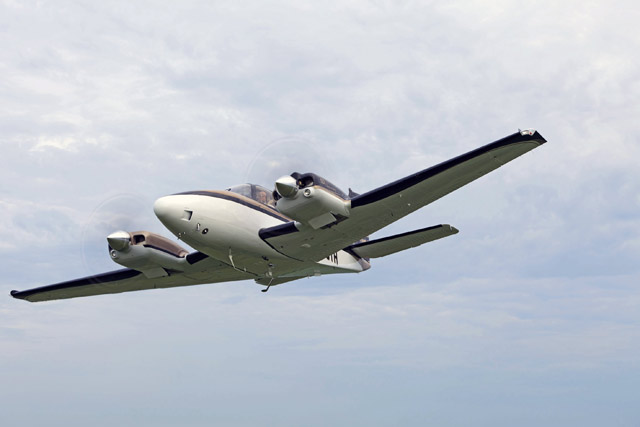Type-specific training gives Bonanza and Baron pilots an edge

The weather is low and scuzzy. You’re in the clouds with an engine failure in your single-engine airplane. Can you make it safely down? If you can maneuver your way to the final approach fix for an instrument procedure at or above 3,500 feet above ground level, you’re golden in a Beech Bonanza. Use the lateral guidance of the approach and glide to the runway. And, oh, by the way, if you have a choice of an ILS or an LPV approach in such a situation—choose the LPV, as you will get rock solid vertical guidance all the way to the runway.
Should that engine failure occur right after takeoff, when you’re at about a 10-degree nose-up attitude, know that in your Bonanza you’re going to need to pitch about six degrees nose down to establish a safe glide. That 16-degree swing can be terrifyingly difficult if you’ve never seen the ground rush up at you before, so practice it a few times.
Those are just a few of the exercises Bonanza and Baron pilots get to experience when going through the model-specific training provided by the Bonanza & Baron Pilot Training (BPT) program. The weekend courses provide pilots access to BPT instructors with thousands of hours of experience in Beech airplanes—instructors who have flown the models to every corner of the flight envelope, and who are expert in showing owners how to get the most out of the airframe when things are going wrong.
The training is offered a dozen or so weekends a year around the country. Ground school occurs in a hotel conference room, with first-time attendees going through a standardized curriculum that focuses on Beechcraft systems and procedures. Recurrent attendees have their own ground school courses on advanced flying techniques. I completed my second such course in Richmond, Virginia, in November 2014, a well-spent weekend brushing up on how best to fly my Bonanza while soaking up the expertise of the most knowledgeable instructors available. The weekend with a couple dozen other pilots also includes time for hangar flying and socializing.
The day and a half of ground school breezes by and it’s soon time to head to the airport, where I have the good fortune to be paired with instructor Bill Hale, who is renowned for his knowledge of Barons and Bonanzas. The weather couldn’t be better for instrument work. Windy, turbulent, a little snow, and scuzzy clouds—the real deal. I won’t need the hood. In just a couple of hours I’ve flown a variety of approaches to Charlottesville, Virginia, and Richmond—hand-flown and coupled. We enter a hold over the Gordonsville VOR and I watch as the Garmin gear in my panel expertly compensates for the brutal winds. While hand flying is emphasized, so is instruction in how to safely use whatever gear the pilot has in his panel.
Hale seems pleased with my flying skills, but can always find a few areas where my technique can be improved. With his coaching I finesse my liftoff technique to prevent even the slightest drift, even with a robust crosswind.
I come away with an instrument proficiency check, a flight review, a host of new tools and techniques to keep honing my skills, and a great deal of respect for the experienced instructors who give up their weekends to spread safety and proficiency to the Beechcraft crowd.
BPT President John Andrick, a Boston Center controller who teaches an ATC communications course over the weekend, said their biggest challenge is convincing pilots they need the advanced training. In other cases, pilots seem to be intimidated by the notion of flying with such capable instructors. The group works hard to reduce that intimidation factor. There is no pass/fail element to the weekend and even the most experienced Beechcraft pilots always come away learning something, Andrick assures.
Pilots can choose the full weekend course of ground school and flying for $1,395; it’s $895 to take the ground school on site and fly with a BPT instructor later near your home. Some pilots choose to just attend the ground school for $595. A companion ground school is $295. A companion can fly with a BPT instructor to learn to land the airplane for $295.
Email [email protected]
Web: www.pbpt.org
Training options
Bonanza and Baron pilots are blessed with a variety of high-quality training options. The BPT program is an outgrowth of a course started by the American Bonanza Society decades ago. ABS a few years ago decided to take its Bonanza/Baron Pilot Proficiency Program (BPPP) in a different direction, hoping to attract a greater percentage of its members. It now offers Beechcraft Pilot Proficiency Program ground school online free to ABS members. Members can then choose to fly with an approved ABS instructor in their area for $395.
Convinced that there was still a place for weekend ground and flight courses, several members of the original BPPP organization used their own money to launch the Bonanza & Baron Pilot Training program (BPT), which has continued the time-tested weekend ground and flight courses with the cadre of highly experienced instructors. BPT President John Andrick said he is expanding the program to include ground and flight training for owners of the Columbia/Cessna Corvalis/TTx models now that Beech and Cessna are both owned by Textron. The engines and avionics on new Bonanzas, Barons, and TTxs are very similar, making it practical to fold the two together. —TBH



